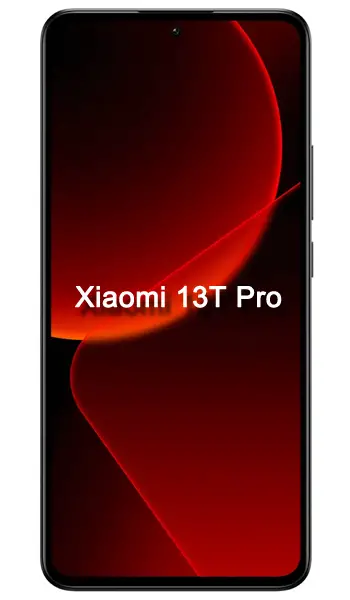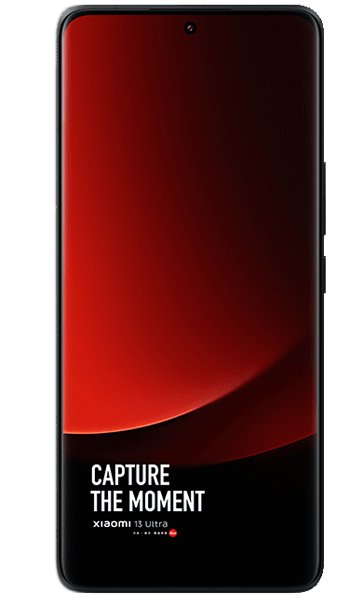Xiaomi 13T Pro vs Xiaomi 13 Ultra Comparison and Differences
Smartphone 1

Xiaomi 13T Pro
Smartphone 2

Xiaomi 13 Ultra
Smartphone 3
Differences between Xiaomi 13T Pro and Xiaomi 13 Ultra - Which to Choose?
Xiaomi 13T Pro - Key Advantages:
- Faster Charging: The 13T Pro boasts a remarkable 120W fast charging capability, promising a full charge in just 19 minutes. This is significantly quicker than the 13 Ultra's charging speed.
- Lighter Weight: At 200 grams, it is more lightweight compared to the 13 Ultra, making it potentially more comfortable to hold and carry.
- Advanced GPU: It comes with the Immortalis-G715 MC11 GPU, which could offer excellent graphics performance.
- Pricing: The 13T Pro is priced at around $700, making it more affordable than the 13 Ultra, providing a more budget-friendly option with robust features.
- Antutu Score: It has a higher Antutu benchmark score (1498628), suggesting potentially better overall performance.
Xiaomi 13 Ultra - Key Advantages:
- Superior Display: The 13 Ultra features a larger 6.73-inch LTPO AMOLED display with a higher resolution (1440 x 3200) and a higher PPI (522), offering sharper and more vibrant visuals.
- Enhanced Camera Setup: It boasts a quad-camera system with a unique 50 MP periscope telephoto lens, offering greater versatility and higher quality in photography.
- Improved Selfie Camera: The front camera is a 32 MP sensor, superior to the 20 MP sensor on the 13T Pro, potentially offering better selfie and video call quality.
- More Robust Build Quality: The 13 Ultra comes with a Gorilla Glass Victus front and an eco leather back, indicating a potentially more premium build.
- Additional Features: It includes a barometer in its sensor array and offers wireless charging and reverse wireless charging capabilities, features not available in the 13T Pro.
Conclusion:
Choose the Xiaomi 13T Pro if: you prioritize fast charging, a lighter device, a high-performing GPU, and a more affordable price point.
Choose the Xiaomi 13 Ultra if: your focus is on a superior display, an advanced camera system, a better selfie camera, premium build quality, and additional features like wireless charging.
Each phone has its unique strengths, so the better choice depends on which features are more important to you in a smartphone.
Xiaomi 13T Pro or Xiaomi 13 Ultra Specs Comparison
 Common specs
Common specs
| Brand and model | Xiaomi 13T Pro | Xiaomi 13 Ultra | |
| Rating | (+0) | (+0) | |
| Release date | 2023, September 26 | 2023, April 18 | |
| Dimensions (HxWxD) | 162.2 x 75.7 x 8.5 mm | 6.39 x 6.39 x 2.98 in | 163.2 x 74.6 x 9.1 mm | 6.43 x 6.43 x 2.94 in | |
| Weight | 200 g | 7.05 oz | 227 g | 8.01 oz | |
| Body Build | Glass front (Gorilla Glass 5), glass back or silicone polymer back, plastic frame | Glass front (Gorilla Glass Victus), eco leather back, aluminum frame | |
| Case | buy from Amazon | buy from Amazon | |
| Colors | Alpine Blue, Meadow Green, Black | Black, Olive Green, White, Orange, Yellow, Blue | |
| Battery | 5000 mAh, Li-Po, non-removable | 5000 mAh, Li-Po, non-removable | |
| Approximate price | $ 480.00 | 1200 EUR | |
| Check price | from Amazon | from Amazon |
 Screen
Screen
| Technology | AMOLED | LTPO AMOLED | |
| Touchscreen | capacitive touchscreen | capacitive touchscreen | |
| Display colors | 68B | 1B | |
| Screen size | 6.67" in | 6.73" in | |
| Screen area | 107.4 cm2 | 108.9 cm2 | |
| Screen format | 20:9 (height:width) | 20:9 (height:width) | |
| Screen to body ratio | 87.5% | 89.5% | |
| Screen resolution | 1220 x 2712 px | 1440 x 3200 px | |
| Screen PPI /points per inch/ | 446 PPI | 522 PPI | |
| Screen protection | Corning Gorilla Glass 5 | Corning Gorilla Glass Victus | |
| Other specs | - 144Hz, Dolby Vision, HDR10+, 1200 nits (HBM), 2600 nits (peak) - |
- 120Hz, Dolby Vision, HDR10+, 1300 nits (HBM), 2600 nits (peak) | |
| Screen protector | buy from Amazon | buy from Amazon |
 Camera and Video
Camera and Video
| Rear camera, main | 50 MP, Triple | 50.3 MP, Quad | |
| Camera specs | -50 MP, f/1.9, 24mm (wide), 1/1.28", 1.22µm, PDAF, OIS -50 MP, f/1.9, 50mm (telephoto), 1/2.88", 0.61µm, PDAF, 2x optical zoom -12 MP, f/2.2, 15mm (ultrawide), 1/3.06", 1.12µm |
-50 MP, f/1.9 or f/4.0, 23mm (wide), 1.0"-type, 1.6µm, multi-directional PDAF, Laser AF, OIS -50 MP, f/3.0, 120mm (periscope telephoto), 1/2.51", Dual-Pixel PDAF, OIS, 5x optical zoom -50 MP, f/1.8, 75mm (telephoto), 1/2.51", Dual-Pixel PDAF, OIS, 3.2x optical zoom -50 MP, f/1.8, 12mm, 122˚ (ultrawide), 1/2.51", Dual-Pixel PDAF -TOF 3D, (depth) |
|
| Functions | Leica lens, LED flash, HDR, panorama | Leica lenses, Dual-LED flash, HDR, panorama, 67mm filter ring holder (optional) | |
| Video | 8K@24fps, 4K@24/30/60fps, 4K/1080p@30fps HDR10+, 1080p@30/60/120/240fps; 10-bit LOG, gyro-EIS | 8K@24fps, 4K@24/30/60fps, 1080p@30/60/120/240/480/960/1920fps, gyro-EIS, Dolby Vision HDR 10-bit rec. (4K@60fps, 1080p) | |
| DxOMark Main Score | 131 | 140 | |
| DxOMark Photo | 135 | 138 | |
| DxOMark Video | 134 | 137 | |
| Front camera, selfie | 20 MP, Single | 32 MP, Single | |
| Specifications | 20 MP, f/2.2, (wide), 0.8µm | 32 MP, f/2.0, 22mm (wide), 0.7µm | |
| Functions | HDR | HDR, panorama | |
| Video | 1080p@30fps, HDR10+ | 1080p@30/60fps | |
| DxOMark Selfie Score | 128 | ||
| DxOMark Photo | 123 | ||
| DxOMark Video | 137 |
 Performance
Performance
| Operating system - OS | Android 13, up to 4 major Android upgrades, HyperOS | Android 13, MIUI 14 | |
| Chipset | - Mediatek Dimensity 9200+ (4 nm) | - Qualcomm SM8550-AB Snapdragon 8 Gen 2 (4 nm) | |
| CPU | - Octa-core (1x3.35 GHz Cortex-X3 & 3x3.0 GHz Cortex-A715 & 4x2.0 GHz Cortex-A510) | - Octa-core (1x3.2 GHz Cortex-X3 & 2x2.8 GHz Cortex-A715 & 2x2.8 GHz Cortex-A710 & 3x2.0 GHz Cortex-A510) | |
| GPU | Immortalis-G715 MC11 | Adreno 740 | |
| External memory | No | No | |
| Internal memory | 256GB 12GB RAM, 512GB 12GB RAM, 1TB 16GB RAM | 256GB 12GB RAM, 512GB 16GB RAM, 1TB 16GB RAM |
 Benchmark
Benchmark
| Antutu 10 Total | 1498628 | ||
| Antutu 10 CPU | 377101 | ||
| Antutu 10 GPU | 521407 | ||
| Antutu 10 Mem | 324294 | ||
| Antutu 10 UX | 377101 | ||
| Antutu 9 Total | 1311316 | ||
| GeekBench 5 Single Core | 1495 | ||
| GeekBench 5 Multi-Core | 5094 |
 Communication and Connectivity
Communication and Connectivity
| SIM card | Nano-SIM and eSIM or Dual SIM (Nano-SIM, dual stand-by) | Dual SIM (Nano-SIM, dual stand-by) | |
| Network | GSM / HSPA / LTE / 5G | GSM / CDMA / HSPA / EVDO / LTE / 5G | |
| Bands | -2G - GSM 850 / 900 / 1800 / 1900 - SIM 1 & SIM 2 -3G - HSDPA 800 / 850 / 900 / 1700(AWS) / 1900 / 2100 -4G - 1, 2, 3, 4, 5, 7, 8, 12, 13, 17, 18, 19, 20, 25, 26, 28, 32, 38, 39, 40, 41, 42, 48, 66 -5G - 1, 3, 5, 7, 8, 20, 28, 38, 40, 41, 66, 75, 77, 78 SA/NSA |
-2G - GSM 850 / 900 / 1800 / 1900 - SIM 1 & SIM 2 CDMA 800 -3G - HSDPA 800 / 850 / 900 / 1700(AWS) / 1900 / 2100 CDMA2000 1xEV-DO -4G - 1, 3, 4, 5, 7, 8, 12, 17, 18, 19, 26, 34, 38, 39, 40, 41, 42 -5G - 1, 3, 5, 8, 28, 38, 40, 41, 77, 78, 79 SA/NSA |
|
| Speed | HSPA, LTE, 5G | HSPA, LTE-A, 5G | |
| GPRS | Yes | Yes | |
| Edge | Yes | Yes | |
| Wi-Fi | Wi-Fi 802.11 a/b/g/n/ac/6e/7, dual/tri-band (market/region dependent), Wi-Fi Direct | Wi-Fi 802.11 a/b/g/n/ac/6e, dual-band, Wi-Fi Direct | |
| GPS | GPS (L1+L5), GLONASS (G1), GALILEO (E1+E5a), NavIC (L5), BDS | GPS (L1+L5), GLONASS (L1), BDS (B1I+B1c+B2a), GALILEO (E1+E5a), QZSS (L1+L5), NavIC (L5) | |
| NFC | Yes | Yes | |
| USB | USB Type-C 2.0, OTG | USB Type-C 3.2, DisplayPort, OTG | |
| Bluetooth | 5.4, A2DP, LE | 5.3, A2DP, LE, aptX HD, aptX Adaptive |
 Music and Audio
Music and Audio
| Radio | No | No | |
| Headphone jack | No | No | |
| Others | - 24-bit/192kHz Hi-Res audio | - 24-bit/192kHz audio |
 Other features
Other features
| Sensors | - Fingerprint (under display, optical), accelerometer, gyro, proximity, compass, color spectrum , Infrared port | - Fingerprint (under display, optical), accelerometer, proximity, gyro, compass, color spectrum, barometer , Infrared port | |
| Other extras |
- 120W Fast charging, Power Delivery 3.0, Quick Charge 4, 100% in 19 min - IP68 dust/water resistant (up to 1.5m for 30 min) |
- Fast charging 90W, 100% in 35 min -Power Delivery 3.0 -Quick Charge 4 -Wireless charging 50W, 100% in 49 min -Reverse wireless charging 10W - IP68 dust/water resistant (up to 1.5m for 30 min) |
